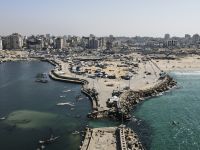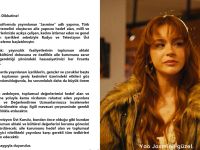By Nigel Thorpe - Head of English Copy Desk
In the wake of the growing number of Palestinian casualties that followed the provocative visit of Ariel Sharon, the leader of Israel's opposition Likud party, to Al-Aqsa Mosque in Jerusalem, Al-Quds newspaper and B'Tselem (the Israeli Center for Human Rights in the Occupied Territories) are again highlighting the Israeli army's use of a new type of lethal "rubber bullet" against demonstrators.
In late February 1999, a Reuters' report on violent Palestinian demonstrations in Hebron, West Bank described how "(Israeli) troops responded with rubber-coated metal bullets and live ammunition. This was one of the relatively rare occasions when someone finally described this type of ammunition not by the innocuous name "rubber bullets", but described them as they really are - "rubber-coated steel bullets.”
The story of the "rubber bullet" began over thirty years ago in the cool, rain-swept streets of Belfast, Northern Ireland, far from the dusty summer heat of Jerusalem. The "rubber bullet had been hastily developed for the use of the British army when controlling demonstrations in Northern Ireland. The original "rubber bullet" really was a rubber bullet consisting of a solid, blunt nosed cylinder of rubber with a weight of 150gms, a length of 5.75 inches (14.6 cm) and a diameter of 1.5 inches (3.8 cm). After its initial tests on sheep, it was found to be sufficiently barbaric for use on Irish human beings. Barbaric perhaps, but the novel ammunition was not as barbaric, or as accurate, as the security forces had hoped. Rubber bullet mark 1 was soon replaced by the plastic bullet which had a muzzle velocity of nearly 200 km per hour. The innocuous "rubber bullet" had started on the first stage of its deadly evolutionary development. The "mark 2" plastic coated bullet indeed proved more lethal than the humble rubber "mark 1" rubber bullet it replaced. By the end of July 1981, there had been one death for every 4,000 plastic-coated rounds fired, compared with one for every 18,000 rubber bullets.
Next came the "mark 3" rubber bullets developed in the 80's. These were in fact steel bullets with a thin rubber coating. They continued to be used by security forces who believed that "rubber bullets" are less lethal than live ammunition, and are therefore an appropriate weapon for use in dispersing demonstrations.
The Northern Ireland causality figures, however, pale into statistical insignificance when compared with the latest figures available from the occupied territories. From the beginning of the Intifada, until the end of October 1998, at least fifty-seven Palestinians have been killed by "rubber bullets". The dead included twenty-eight children under seventeen of whom, thirteen were younger than thirteen. Hundreds more Palestinians have been injured. When the final causalities from the October demonstrations are available, it is certain that the humble projectile will have reaped a bumper harvest of victims at the beginning of the new millennium.
How can the differences in causality figures between Northern Ireland and the occupied territories be explained? It now seems that two deadly factors are involved; first, the misuse of this type of weapon in riot control, and second, changes in the bullet's design. The story of Palestinian student, Nasir Ereikat, first told nearly two years ago by the Al-Quds newspaper, highlights both of these factors.
Wasem Ereikat, 52, Nasir's uncle, told Al-Quds that "at 1.45 p.m. and after the end of the protests (by the students of Jerusalem University in 1998), my nephew came to my house in the old city. While he was about to enter the house with his book bag on him, an Israeli police patrol arrived on the scene. The commander of the patrol stepped out of the police vehicle and aimed directly at Nasir's head and fired. His (blood from his brain) was splashed around. When his father and two brothers attempted to take him to hospital, the Israeli troops prohibited them and beat the father. Nasir's father also suffered head injuries during the Israeli soldier's attack.”
According to the Open-Fire Regulations used by the Israeli occupation army, "rubber bullets" should only have been fired at the legs of a person who has been identified as one of the rioters or stone-throwers. The regulations also explicitly prohibit the firing of "rubber bullets" at a distance of less than forty meters and at children. It is impossible to reconcile Nasir's case, and recent causality figures, with these guidelines.
In the same year as Nasir's death, New York Times correspondent Joel Greenberg was an eye-witness to the shooting death of eight-year old Ali Jawarish in Jerusalem and told B'Tselem, "when the soldier fired, he was some fifteen to twenty meters from the fleeing children. At that time, some children were detained and others were fleeing, no stones were thrown. After the firing, the soldiers retreated. When they did so, I noticed a child, around nine or ten years old, lying motionless on the ground.”
Yet in the vast majority of cases, no legal action has been taken against soldiers who shot "rubber bullets" and killed Palestinians. In the three cases where the authorities did take action, one soldier was acquitted, one was given a twenty-two months' sentence, and one was subjected to disciplinary proceedings.
The second act of Nasir Ereikat's story illustrates that besides misuse, successive refinements of the "rubber bullet" are also responsible for the escalating causality figures.
After a long delay, the Israeli soldiers finally allowed the family to take Nasir to the Al Makkased Hospital in Jerusalem where he was proclaimed brain dead. Two days later, a large Israeli intelligence force raided the hospital and seized the bullets that the Israeli forces had fired at Nasir.
Suleiman Turkam of the Makkased Hospital told the Palestinian news agency WAFA that "Israeli intelligence units attended to the hospital in the early hours of the morning yesterday and demanded the bullets extracted from the dead student's head." Turkam went on to comment "we have hundreds of metallic rubber and live bullets and the Israeli intelligence have never come to collect them (before)". The unusual interest in this one bullet was perhaps because it was of a new type and consisted of a "cylinder which contains what appears to be explosive materials in it.”
Medical sources at Beit Jala Hospital also confirmed that a new type of rubber coated metallic bullet had been used by the Israeli occupation forces during the last two days of the demonstrations. They described the new bullet as being " cylindrical in shape with a rectangular base made of rubber and a metal piked (spear-shaped)end. The unfortunate victims of the new deadly breed of "rubber bullets" need surgery to extract the projectile from their bodies.
In the two years that have passed since Nasir's death an ever growing number of innocent victims have been hit, not by rubber bullets in the legs, but by high tech rubber-coated steel bullets in the head.
If words are the ammunition of diplomats and negotiators engaged in historic negotiations, it is time to use them accurately and objectively; occupied territories are truly occupied territories, but "rubber bullets" should be recognized as the lethal bullets used, often deliberately, in a lethal way.
The international community should be looking not only to control landmines which explode beneath innocent feet, but also to curb the use of "flying missiles" which are directed by security forces at innocent heads — Albawaba.com
© 2000 Al Bawaba (www.albawaba.com)







